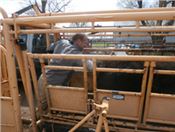Improve Pregnancy Rate With A Pre-Breeding Exam

A veterinarian doing a pre-breeding exam on a yearling heifer.
Photo credit: MU Extension
MT. VERNON, MO.
One of the early requirements in the Missouri Show-Me-Select Heifer Program is the pre-breeding examination.
“The exam, done by a veterinarian, normally four to six weeks before breeding will increase the pregnancy rate in virgin heifers,” said Eldon Cole, a livestock specialist with University of Missouri Extension.
The exam is done by rectal palpation. The veterinarian feels for the normalcy and stage of development of the female's reproductive tract. They score the tract on a 1 to 8 rating system. Heifers scoring a 1 have an infantile tract and the chances of them breeding is very low.
The freemartin condition, normally seen when a heifer calf is born or carried some time along with a bull calf, is scored an 8. Each of these scores, basically means they’re poor candidates to be artificially bred or turned with the bull.
The other scores should be considered as follows: 2 indicates the heifer is not cycling and needs more time and probably more feed to start cycling; a 3 is not cycling but getting close. A 4 is cycling or soon will, a 5 definitely has cycled, a 6 is given if the heifer is pregnant, and a 7 indicates a shot was given to abort her.
After the veterinarian tract scores the heifer, they measure height and width of the pelvic opening. The Show-Me-Select program requires heifers to have a minimum of 150 square centimeters pelvic opening.
Heifers close to the minimum are given a second chance and are measured a second time at the first pregnancy test. At that time, they must have at least a 180 square centimeters opening.
During the exam in the Missouri program, heifers are checked for phenotype problems such as lameness, temperament, pinkeye scars, light muscling, extreme frame size and several other blemishes such as frost-bitten ears and tails.
EXAM REDUCES PROBLEMS
“The veterinarian’s information improves the virgin heifer conception rate and the bunching of their calf crop,” said Cole.
The recommendation for top first service conception is to have at least one-half of the heifers scoring a 4 or 5 at pre-breeding.
Back in November, Cole received data on the pre-breeding scores of 40 heifers.
“Four of the 40 were eliminated because of either a very small pelvic opening or a two-tract score,” said Cole. “The veterinarian found one heifer 4.5 months pregnant and another was a freemartin.”
By doing the exam, the owner eliminated 15 percent of the potential replacement problem right upfront before wasting time with heat synchronization protocols, artificial insemination, and the associated costs.
“Just because a heifer is the biggest one in the bunch showing great eye appeal doesn’t mean she’s a keeper. Let your veterinarian help you decide which ones to keep,” said Cole. ∆